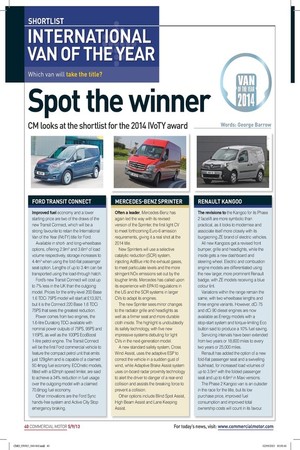Spot the winner CM looks at the shortlist for the 2014 IVoTY award Words: George Barrow FORD TRANSIT CONNECT
Page 32

If you've noticed an error in this article please click here to report it so we can fix it.
Improved fuel economy and a lower starting price are two of the draws of the new Transit Connect, which will be a strong favourite to retain the International Van of the Year (IVoTY) title for Ford.
Available in shortand long-wheelbase options, offering 2.9m3 and 3.6m3 of load volume respectively, storage increases to 4.4m3 when using the fold-flat passenger seat option. Lengths of up to 3.4m can be transported using the load-through hatch.
Ford's new Transit Connect will cost up to 7% less in the UK than the outgoing model. Prices for the entry-level 200 Base 1.6 TDCi 75PS model will start at £13,921, but it is the Connect 220 Base 1.6 TDCi 75PS that sees the greatest reduction.
Power comes from two engines, the 1.6-litre Duratorq TDCi available with nominal power outputs of 75PS, 95PS and 115PS, as well as the 100PS EcoBoost 1-litre petrol engine. The Transit Connect will be the first Ford commercial vehicle to feature the compact petrol unit that emits just 129g/km and is capable of a claimed 50.4mpg fuel economy. ECOnetic models, fitted with a 62mph speed limiter, are said to achieve a 34% reduction in fuel usage over the outgoing model with a claimed 70.6mpg fuel economy.
Other innovations are the Ford Sync hands-free system and Active City Stop emergency braking. MERCEDES-BENZ SPRINTER
Often a leader, Mercedes-Benz has again led the way with its revised version of the Sprinter, the first light CV to meet forthcoming Euro-6 emission requirements, giving it a real shot at the 2014 title.
New Sprinters will use a selective catalytic reduction (SCR) system, injecting AdBlue into the exhaust gases, to meet particulate levels and the more stringent NOx emissions set out by the tougher limits. Mercedes has called upon its experience with EPA10 regulations in the US and the SCR systems in larger CVs to adapt its engines.
The new Sprinter sees minor changes to the radiator grille and headlights as well as a firmer seat and more durable cloth inside. The highlight is undoubtedly its safety technology, with five new impressive systems debuting for light CVs in the next-generation model.
A new standard safety system, Cross Wind Assist, uses the adaptive ESP to correct the vehicle in a sudden gust of wind, while Adaptive Brake Assist system uses on-board radar proximity technology to alert the driver to danger of a rear-end collision and assists the breaking force to prevent a collision.
Other options include Blind Spot Assist, High Beam Assist and Lane Keeping Assist. RENAULT KANG00
The revisions to the Kangoo for its Phase 2 facelift are more symbolic than practical, as it looks to modernise and associate itself more closely with its burgeoning ZE brand of electric vehicles.
All new Kangoos get a revised front bumper, grille and headlights, while the inside gets a new dashboard and steering wheel. Electric and combustion engine models are differentiated using the new larger, more prominent Renault badge, with ZE models receiving a blue colour tint.
Variations within the range remain the same, with two wheelbase lengths and three engine variants. However, dCi 75 and dCi 90 diesel engines are now available as Energy models with a stop-start system and torque-limiting Eco button said to produce a 10% fuel saving.
Servicing intervals have been extended from two years or 18,600 miles to every two years or 25,000 miles.
Renault has added the option of a new fold-flat passenger seat and a swivelling bulkhead, for increased load volumes of up to 3.5m3 with the folded passenger seat and up to 4.6m3 in Maxi versions.
The Phase 2 Kangoo van is an outsider in the race for the title, but its low purchase price, improved fuel consumption and improved total ownership costs will count in its favour.









































